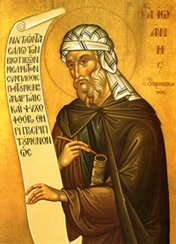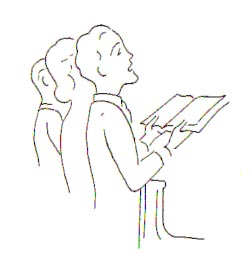|
The New Curriculum
Vol 2. An Introduction to the Byzantine 8 modes

How does the new Curriculum introduce byzantine
simple chanting of the eight modes in an extremely
easy and original way to students? What is the new
concept of teaching the eight Byzantine modes all about?
|
|
In the Practical Part

|
|
Introduction
This volume constitutes the fastest and most efficient way to learn Byzantine chanting.
It teaches students the minimum skills they should have to be able to read all simple Byzantine compositions (mostly used) and to chant at church in a very acceptable way.
|
|
The Old Method for Teaching the 8 Modes
The classical way for teaching the 8 modes usually refers to the Anastasimatarion as a reference book of teaching. Yet the Anastasimatarion is not a teaching book; it is a chanting book that encompasses all the chants of the vespers and matins of Saturday and Sunday addressing the resurrection of Christ. It is the most used book in the Byzantine liturgy.
In some schools, they have added few exercises introducing each mode.
Yet, as far as we know, there hasn't been yet any method for teaching the 8 modes.
If you just go over the Anastasimatarion you will have too many repeated phrases which reduces the learning focus of students and lengthens the duration of the learning.
|
|
The New Method for Teaching the 8 Modes
In our curriculum, we have grouped the main musical phrases of each mode. We reached a number of around 15 phrases only in each mode. Then we added to each phrase the possible minor changes that occurred in the Anastasimatarion.
So, in each mode the teaching strategy became as follows:
- Memory Exercises:
These are small phrases that the student memorizes as hints to be able to enter in each mode quickly by chanting these phrases.
- Introductory Exercises:
These are general few exercises that introduce the intervals of the mode. They aim at teaching the student the main basic notes of the mode and how he should think when moving between the different notes of the mode.
- General Phrases as Solfege:
In each of the Melismatic and Stashiraric styles, the teacher starts by reading each main phrase, then each of the students will have to read one of its forms (that have slight changes).
The concept of learning Byzantine Music became, in the eyes of students, a just mastering of few phrases in each mode; it is not anymore a hard and long time studying a long book that is not a teaching book anyway.
At the end students will have to read paragraphs formed by these phrases.
- General Phrases with Words:
After mastering the phrases, students move to the application of the phrases with different lyrics of the Anastasimatarion. The same process as in the Solfege phrases is applied here as well.
- Chants:
Finally, the students will move to the chants of the Anastasimatarion that they will be able to read very easily especially that they will have read and analyzed a large number of their phrases during previous exercises.
|
|
In this volume the main transpositions in each mode are introduced and learned in a simple way without many details.
It is to be noted that this volume starts with a long rhythmic study of Gorgon. This is due because the simple gorgon is the most utilized form of Gorgon in byzantine Music and hence students should take all their time to master it once for all.
|
|
In the Theoretical Part

|
|
The theoretical part of the 2nd volume encompasses the following main subjects:
- Elements of the Byzantine Melody
An explanation of the different styles of Byzantine Music with all their derivations: Melismatic, Stechiraric,...
- A General Introduction to each of the 8 Modes
A general introduction to the intervals of the Byzantine scales (on the basis of the ¼ division only). The general elements of the 8 modes: Their main basic notes, their phrases.
- An Introduction to Musical Transposition
- Principals of Byzantine Orthography
This is another revolutionary part of the curriculum. The complex rules of Byzantine Orthography were listed by Khourmouziou Khartofilakos in the beginning of the 19th century as a very long list of possibilities and exceptions. In the new curriculum, the possibilities were studied and transformed into simple rules (that lead to the possibilities and exceptions listed by Khourmouziou), then written exercises were developed to teach students these rules in the easiest possible way.
|
|
The Exhibits
This volume has a number of exhibits. The most important are two:
- An introduction to the history of Byzantine Music
This is a introduction with many references that motivates student to research Byzantine Music.
- An introduction to Typicon
An introduction to the rules of the Byzantine Liturgy; the rules that govern the selection of daily chants for the services.
|